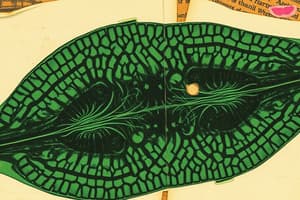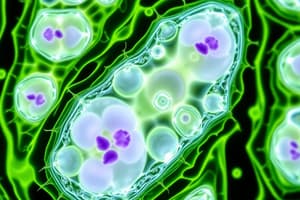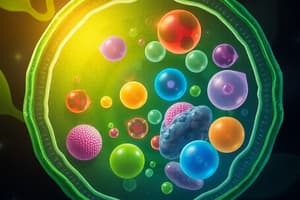Podcast
Questions and Answers
ما هو النوع من органيلレスponsible عن توليد الطاقة من خلال التنفس الخليوي؟
ما هو النوع من органيلレスponsible عن توليد الطاقة من خلال التنفس الخليوي؟
- الGolgi apparatus
- الlysosomes
- /mitochondria/.mitochondria (correct)
- ال chloroplasts
ما هو العنصر النسيجية الرئيسي في جدار الخلية النباتية؟
ما هو العنصر النسيجية الرئيسي في جدار الخلية النباتية؟
- الpectin
- الcellose
- كل من_above (correct)
- الhemicellulose
ما هو الغرض الرئيسي لجهاز جولجي؟
ما هو الغرض الرئيسي لجهاز جولجي؟
- توليد الطاقة
- هضم الخلايا
- نقل البروتينات (correct)
- تخزين المواد الغذائية
ما هو دور الفاكيول في الخلايا النباتية؟
ما هو دور الفاكيول في الخلايا النباتية؟
ما هو الدور الرئيسي للكلورoplast في الخلايا النباتية؟
ما هو الدور الرئيسي للكلورoplast في الخلايا النباتية؟
Flashcards are hidden until you start studying
Study Notes
Structure of a Plant Cell
- Cell Wall: Rigid outer layer composed of cellulose, hemicellulose, and pectin
- Plasma Membrane: Semi-permeable membrane that regulates the movement of substances in and out of the cell
- Cytoplasm: Jelly-like substance inside the cell membrane where metabolic processes take place
- Nucleus: Contained within the cytoplasm, responsible for storing genetic information
- Mitochondria: Organelles responsible for generating energy through cellular respiration
- Chloroplasts: Organelles responsible for photosynthesis, found in plant cells
- Endoplasmic Reticulum (ER): Network of membranous tubules and cisternae involved in protein synthesis and transport
- Golgi Apparatus: Complex of flattened sacs responsible for protein modification and packaging
- Lysosomes: Membrane-bound sacs containing digestive enzymes
- Vacuoles: Membrane-bound sacs that store water, ions, and small molecules
Unique Features of Plant Cells
- Chloroplasts: Contain the pigment chlorophyll, which absorbs light energy for photosynthesis
- Vacuoles: Can occupy up to 90% of the cell volume, helping to maintain cell turgor pressure
- Cell Wall: Provides structural support and protection against external factors
- Plastids: Organelles responsible for pigment synthesis and storage
Functions of Plant Cells
- Photosynthesis: Convert light energy into chemical energy
- Cell Growth and Division: Allow the plant to grow and develop
- Storage: Store nutrients, water, and waste products
- Response to Stimuli: Respond to environmental stimuli, such as light and touch
بنية الخلية النباتية
- الجدار الخلوي: طبقة خارجية صلبة تتكون من سيليولوز وهيميسيليولوز وبيكتين
- الغشاء البلازمي: غشاء شبه مرن ينظم حركة المواد داخل وخارج الخلية
- السيتوبلازم: مادة جليّة داخل الغشاء الخلوي حيث تحدث العمليات الأيضية
- النواة: محتواة داخل السيتوبلازم، مسؤولة عن تخزين المعلومات الجينية
- الميتوكوندريا: عضيات مسؤولة عن توليد الطاقة من خلال التنفس الخلوي
- الكلورoplast: عضيات مسؤولة عن фотосنتез، موجودة في الخلايا النباتية
- الشبكة الإندوبلازمية: شبكة من النتوئات والكسترين الميتمة في توليد البروتينات ونقلها
- الجоли: مجموعة من الكيسات المسطحة المسؤولة عن تعديل وتغليف البروتينات
- الليزوزومات: كيسات محصورة بغشاء تحتوي على إنزيمات هضمية
- الفصيصات: كيسات محصورة بغشاء تخزن الماء والأيونات والجزيئات الصغيرة
الميزات الفريدة للخلايا النباتية
- الكلورoplast: تحتوي على صبغة الكلوروفيل، التي تمتص طاقة الضوء ل فوتوسنتez
- الفصيصات: يمكن أن تشغل حتى 90% من حجم الخلية، مساعدة على الحفاظ على ضغط تورجور الخلية
- الجدار الخلوي: يوفر الدعم الهيكلي والحماية ضد العوامل الخارجية
- البلستيدات: عضيات مسؤولة عن توليد و تخزين الأصباغ
وظائف الخلايا النباتية
- فوتوسنتez: يقوم بت変 quang 光 năng إلى طاقة كيميائية
- نمو ونقسيم الخلية: يسمح النبات بأن ينمو ويطور
- تخزين: تخزن المغذيات والماء والمنتجات الثانوية
- استجابة للمنبهات: يستجيب لمنبهات البيئية، مثل الضوء واللمس
Studying That Suits You
Use AI to generate personalized quizzes and flashcards to suit your learning preferences.




